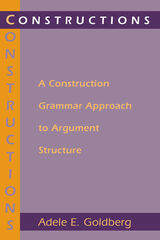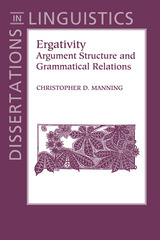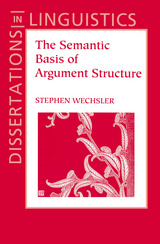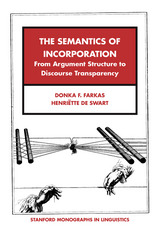4 books about Argument Structure

Constructions
A Construction Grammar Approach to Argument Structure
Adele E. Goldberg
University of Chicago Press, 1995
Drawing on work in linguistics, language acquisition, and computer science, Adele E. Goldberg proposes that grammatical constructions play a central role in the relation between the form and meaning of simple sentences. She demonstrates that the syntactic patterns associated with simple sentences are imbued with meaning—that the constructions themselves carry meaning independently of the words in a sentence.
Goldberg provides a comprehensive account of the relation between verbs and constructions, offering ways to relate verb and constructional meaning, and to capture relations among constructions and generalizations over constructions. Prototypes, frame semantics, and metaphor are shown to play crucial roles. In addition, Goldberg presents specific analyses of several constructions, including the ditransitive and the resultative constructions, revealing systematic semantic generalizations.
Through a comparison with other current approaches to argument structure phenomena, this book narrows the gap between generative and cognitive theories of language.
Goldberg provides a comprehensive account of the relation between verbs and constructions, offering ways to relate verb and constructional meaning, and to capture relations among constructions and generalizations over constructions. Prototypes, frame semantics, and metaphor are shown to play crucial roles. In addition, Goldberg presents specific analyses of several constructions, including the ditransitive and the resultative constructions, revealing systematic semantic generalizations.
Through a comparison with other current approaches to argument structure phenomena, this book narrows the gap between generative and cognitive theories of language.
[more]

Ergativity
Argument Structure and Grammatical Relations
Christopher D. Manning
CSLI, 1996
This volume considers and examines some of the phenomena that have led languages to be considered 'ergative'. Languages considered 'ergative' have only been sparsely studied, and many fundamental questions in their analysis seem at best incompletely answered. This volume fills that void by focussing on some of the basic issues: when ergativity should be analyzed as syntactic or morphological; whether languages can be divided into two classes of syntactically and morphologically ergative languages, and if so where the division should be drawn; and whether ergative arguments are always core roles or not.
Christopher Manning's codification of syntactic approaches to dealing with ergative languages is based on a hypothesis he terms the 'Inverse Grammatical Relations hypothesis.' This hypothesis adopts a framework that decouples prominence at the levels of grammatical relations and argument structure. The result is two notions of subject: grammatical subject and argument structure subject and a uniform analysis of syntactically ergative and Philippine languages. These language groups, the syntactically ergative and Philippine languages, allow an inverse mapping in the prominence of the two highest terms between argument structure and grammatical relations. A level of argument structure is shown to be particularly well motivated by the examination of syntactically ergative languages. A study of Inuit, Tagalog, and Dyirbal shows that constraints on imperative addressee and controllee selection, antecendent of anaphors, and the controller of certain adverbial clauses are universally sensitive to argument structure. Thus, these phenomena are always accusative or neutral, explaining why passive agents and causes can generally bind reflexives. However, constraints on relativization, topicalization, focussing or questioning, specificity or wide scope, coreferential omission in coordination, etc. are shown to be universally sensitive to grammatical relations. Examining just these phenomena, which are sensitive to grammatical relations, it becomes evident that many languages are indeed syntactically ergative, and so must be countenanced by linguistic theory.
This volume combines good scholarship with innovative ideas into an important work that will appeal to a wide range of linguists and scholars.
[more]

The Semantic Basis of Argument Structure
Stephen Wechsler
CSLI, 1995
Stephen Wechsler
Subject: Linguistics; Semantics; Grammar--Syntax
[more]

The Semantics of Incorporation
From Argument Structure to Discourse Transparency
Donka F. Farkas and Henriëtte de Swart
CSLI, 2003
Distinguishing between discourse referents and thematic arguments, the analysis of incorporation proposed by Donka Farkas and Henriettë de Swart accounts for the relationship between morphological and semantic number, the contrasts between incorporated singulars and incorporated plurals, and various "shades" of discourse transparency. The framework of Discourse Representation Theory used is a theory well-suited for connecting sentence-level and discourse-level semantics.
The analysis presented in this book has important consequences for a cross-linguistic theory of anaphora. Linguists and logicians interested in discourse structure, cross-linguistic semantics, and the relationship between morpho-syntax and meaning will find this an engaging and innovative work.
The analysis presented in this book has important consequences for a cross-linguistic theory of anaphora. Linguists and logicians interested in discourse structure, cross-linguistic semantics, and the relationship between morpho-syntax and meaning will find this an engaging and innovative work.
[more]
READERS
Browse our collection.
PUBLISHERS
See BiblioVault's publisher services.
STUDENT SERVICES
Files for college accessibility offices.
UChicago Accessibility Resources
home | accessibility | search | about | contact us
BiblioVault ® 2001 - 2024
The University of Chicago Press









